Photos: Kip Miller
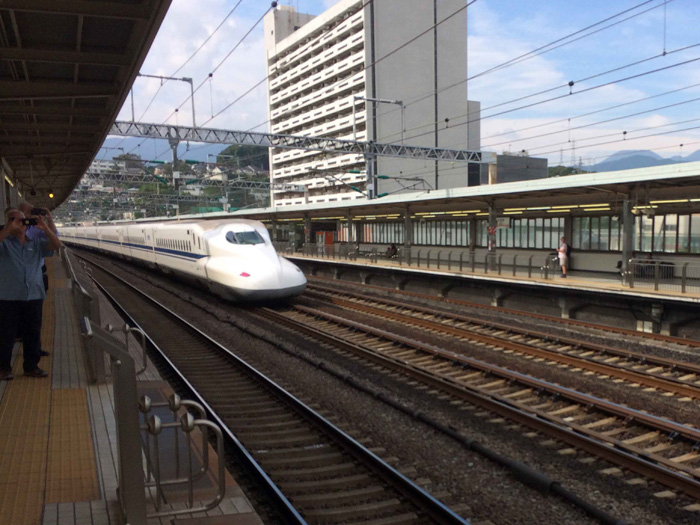
Japan's bullet trains, Shinkansen, are among the world's fastest, with speeds up to 200 miles per hour.
"Before we journey back in time," announces Jay, our knowledgeable
tour director, "you are going to experience something that Japan
is famous for today--a trip on one of our bullet trains! It's a very smooth
ride and in 50 years of operation there has not been a single fatality."
According to my guide book, Shinkansen, Japan's network of high-speed
rail, is managed by Japan Railways Group. Its trains can travel at speeds
of 200 miles per hour. "We are heading to Nagoya where we will switch
to a regular train that continues to Takayama in the mountains,"
he adds. Jay has his train routine down to the last detail: He hands each
of us a seat number and we pass through a special gate, bypassing the
crush of commuters. At our designated track several sleek trains streak
by in a flash. "It feels like we're floating on air!" exclaims
my husband on route. "Amazing, isn't it?" Jay interjects. "More
people ride Japan's bullet trains than any other high-speed trains in
the world. At Nagoya, we board a local train, creeping backwards for 20
minutes before our track is cleared toward Takayama. The retrograde is
apropos, I decide, thinking about time traveling to an old-fashioned town
noted for its wooden houses. The train shifts forward with a jolt, but
the ride is measurably bumpier and slower, a comedown after Shinkansen.
I have been itching for an opportunity to discover the old Japan, to walk on streets lined with historic homes and shops displaying artisanal crafts, and to mingle with the locals as they go about their daily routines. Our traveling companions, Kathy and Eric, share our excitement as our train winds through a pristine alpine landscape dense with pines. By mid-afternoon we arrive in Takayama, a town of 90,000 surrounded by mountains that are 10,000 feet tall. No rice paddies here, I observe, or at least, very few. With unlimited sources of wood, townspeople here always made their living by constructing houses and shops. Renowned for their superb craftsmanship, they soon became the builders of most of Kyoto's temples and shrines during the Edo period.
We board
a local bus and are greeted by Nogukosa, our first female driver. "But
before we go into town," Jay announces, "I want you to experience
the beauty of a traditional tea ceremony." "Terrific,"
Kathy says excitedly as we pull up at Takayama's Chanoyu Museum and Dokaku
Tea House. "Irasshaimase (welcome)," a tea hostess of indeterminate
age at greets us with a discrete smile. Removing our shoes is de rigueur
and we shuffle behind her to a spacious room with tables and chairs arranged
in a U formation. Seasonal flowers and calligraphy screens decorate the
space. She is being assisted by two younger women, all clad in traditional
kimonos.
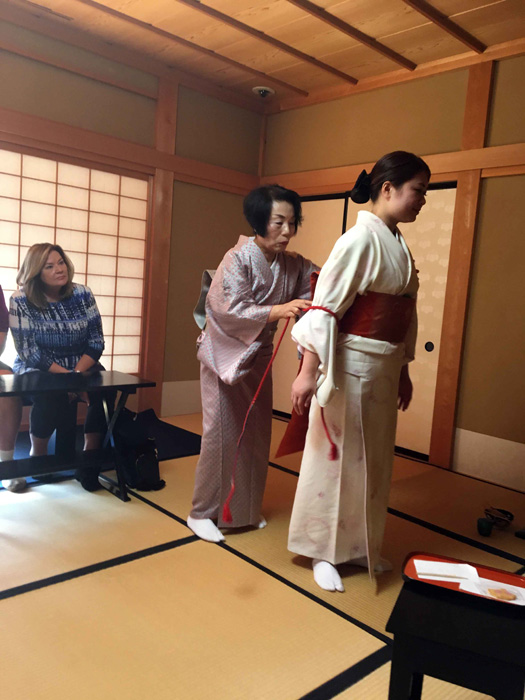
An authentic tea ceremony in Takayama includes a demo of how to wear a kimono.
The Chanuyu tea ceremony was created by Kanamori Sowi, a noted tea guru
from the Edo Period. It is a revered tradition as practiced by masters
of the craft. "We call our tea 'matcha' and it is a very strong tea,"
Jay explains as our hostess begins the choreographed ritual. She is seated
on her knees to attend the fire in a charcoal burner. The teapot is cleaned
and she uses bamboo spoons to pick up the tea powder. She adds boiling
water and stirs the pot as the tea begins to foam and then shows us how
to drink the tea, grasping the sides of the tea bowl, being careful not
to cover the design with her hands. I smile as she noisily slurps the
tea to the last drop, blotting any lip marks remaining on the cup, a procedure
we are each expected to follow. After serving us tea cakes and cookies
of indeterminate flavors, we each drain our own tea bowls, some of which
are prized antiques. "Keep holding the bowl and do not put it down
until you are finished," Jay admonishes us. "As you would expect,
all the ladies here are tea masters," he explains as they begin to
demonstrate how to wear a kimono. "These are made of real silk and
the large sash belt is called an obi," says Jay. They unravel the
obi and I am surprised by its length. When fully wrapped around the waist,
it is tied in front with some rope and lots of knots. "Kimonos and
obis change with the season," Jay comments as we head out to view
the museum's collection of miniature shrines and lacquerware made from
the wings of jewel beetles. "Hey, check out the view below,"
motions my husband, aiming his camera on a colorful garden.
At the Hida
Hotel Plaza, Takayama's tallest structure, we sample Hida beef, the local
wagyu beef, renowned in these parts and rivaling the more familiar Kobe
beef that we've enjoyed at home. In the lobby, a large float is on display,
typical of traditional illuminated floats that are paraded during the
bi-annual Takayama Festival dating from the 1600s. "Too bad we're
missing the festival by just a few days," says Eric. According to
tradition, these elaborate, hand-painted floats (yatai) are mounted on
wheels and pulled by costumed townspeople through the streets of the old
town. "I am eager to see those streets tomorrow, even without the
floats," I remark to Kathy.
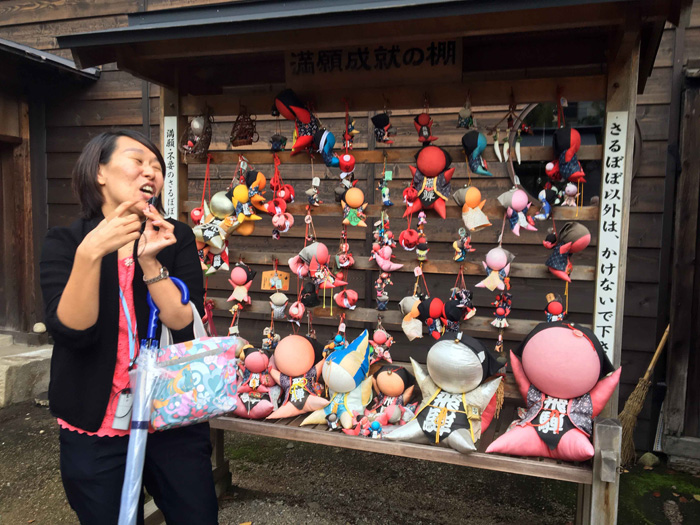
At Takayama's Kokobunji Temple, an array of colorful fabric votives are meant to protect children.
Although the chill morning sky is gray with clouds, Ai, a local guide, is ready to take us on a walking tour through Takayama's shopping streets. "I lived in Cerritos in Los Angeles where I studied English," she reveals as we depart the hotel. We pace ourselves, slowing down to take in as many details as possible. Ai points to an orange sign for Chitose, a popular restaurant specializing in soba fried noodles, and then to Tsukuni Soba, known for thinner noodles in a lighter broth. "They are all worth trying later when you have free time," she claims. "But now we are going to visit an important Buddhist site, the Hida Kokubunji Temple, originally built 748 by Emperor Shomu. Here you will find Takayama's oldest gingko tree, reputed to be 1200 years old." We peer into the courtyard to find a gnarled tree, perhaps 10 meters in circumference. "The local people believe that it is a winter weather predictor," Ai explains. "If there is going to be a lot of snow, all the leaves will drop in one or two days; if the snow is going to be lighter, the leaves drop bit by bit. The tree is about 65% accurate." She points to a row of Jizo statues of Buddah bearing red cups that are used by worshippers "to gather the souls of babies who died before their time." There is also a display of unusual amulets for children in a variety of colors, some made of kimono scraps. "Red means family happiness, green means longevity and health, blue signifies education, and gold prosperity," Ai enumerates.
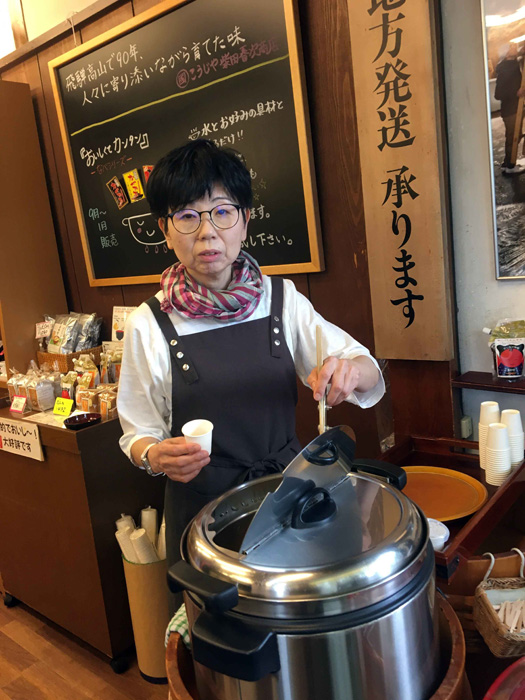
Koujiyamiso, Takayama's renowned miso shop, offers shoppers free tastes of steaming hot soup.
The Miyagawa morning market, the local version of a farmers' market, stretches on the eastern side of a river of the same name, across the Kajibashi Bridge. While the river is somewhat turbulent, its water is crystal clear, and I can see fine white sand on the bottom. We stroll past stalls selling bulbous yams, tiny eggplants, red turnips and aromatic ginger. One vendor specializes in dried fish, another in freshly grilled octopus balls. A colorful flower booth showcases locally grown bouquets. On the opposite side are tiny eateries and mini shops selling specialty products. A little grander is the Koujiyamiso Shop, Takayama's finest miso emporium, offering a large selection of miso products, including a freeze-dried version. A smiling matron, perhaps a family member, offers us cups of steaming miso to taste. It is delicious, the perfect beverage on a chilly morning. "I can see you liked it!" interjects Ai, motioning us to continue to our cooking class, to be held at a nearby Buddhist shrine. Back on Kajibashji Bridge, Jay points to two bronze statues that flank each side: the long-armed man and the long-legged man, two figures revered in Japanese folklore for their cooperative spirit: "Long legs wades in the river carrying long arms on his back as the latter grabs fish right out of the water." "How clever is that," Eric chortles.
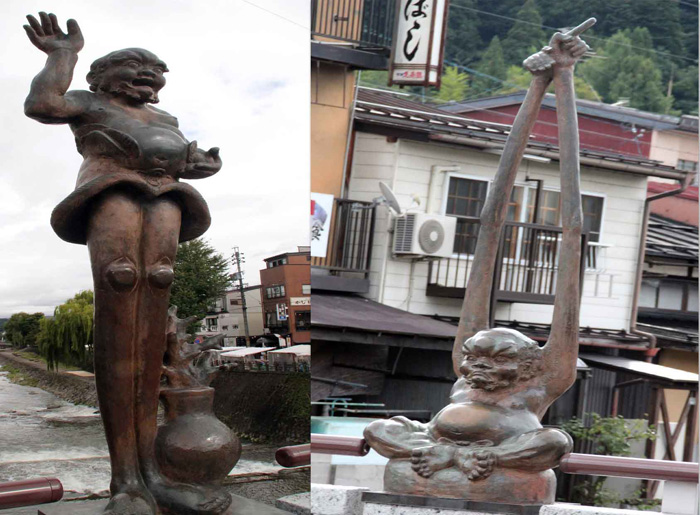
Takayama's Kajibashi Bridge is famous for two bronze statues that are part of the local folklore.
A traditional shrine seems an unlikely site for a cooking class, but we
are pleasantly surprised by the space it offers, its well-equipped kitchen
and three generations of English-speaking teachers: sisters Hisa and Chitose,
mother Yoshie, and grandma Kumiko who keeps a watchful eye over the proceedings.
All the ingredients await us as we take our positions at several stainless
work tables. The teachers get right to work explaining and supervising
our chopping, sorting and sautéeing. The result is a bento box-full
of tangy, delicious, and mostly vegan fare, from miso soup and tiny glazed
potatoes to crispy fried eggplant. We savor our handiwork, having gained
fresh insight into the nuanced world of Japanese cuisine. As I empty my
bento box, I am reminded that Japan has eclipsed France as the country
with the most three-star Michelin ratings.
At the edge
of the town's world renowned historic district, Takayama Jinya is Japan's
last standing government house complex from the Edo period. Because Takayama
was rich in timber, gold, silver and copper, it was put under the direct
control of the Tokugawa Shogunate in the late 17th century. The Jinya
complex is a popular tourist site, visited by thousands of people from
all over the world who come to view its public rooms, storehouses, old
torture chamber and living quarters, or to simply admire its unique all-wood
construction. The Jinya also marks the entrance to Takayama's colorful
old town, lined with distinctive timbered houses, shops and bars. Nearby,
a special building shields one of the city's prized yatais. "The
yatais were originally built to appease the gods after Japan was ravaged
by an outbreak of plague," Jay explains. He leads us down one of
its three main streets, past elegant private homes and tiny inns, alongside
colorful shops and bars, to Funasaka, one of six sake breweries in Takayama.
A ball made out of cedar hangs over the entrance, denoting its status
as a brewery.
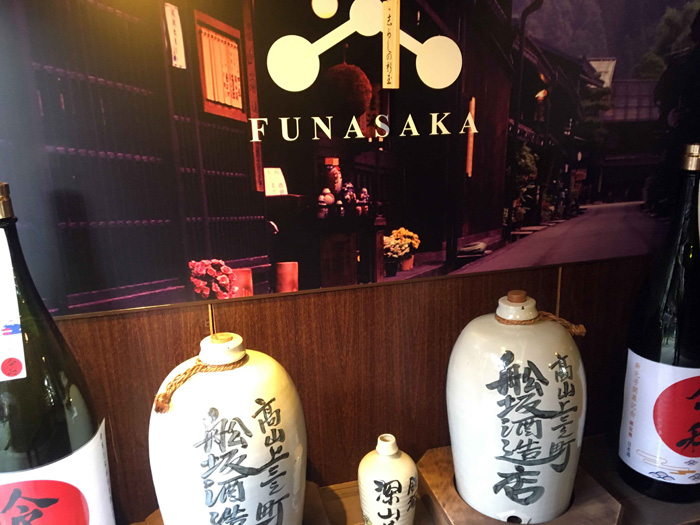
Funasaka, a popular brewery in the heart of Takayama's old town, has been producing high quality sake for over 200 years.
"Come in and take a seat," says Simon, a Swedish employee of
the brewery who is totally fluent in both Japanese and English. Funasaka
is 200 years old," he discloses, "and this site was originally
an old warehouse. The city of Takayama has been producing sake for 1,000
years. Making sake requires three bio conditions: rice, water and weather."
By now Simon has my full attention and I even jot down some notes on his
take of sake production: from the selection of rice and its grain size,
the percentages used, the steaming, cooling, drying, and cultivation of
mold, to the beginning of fermentation. "By the time the rice begins
to ferment, there is a lot of bubbling going on and you can smell it.
In fact, the smell is a trade secret," he admits. After six weeks,
you have a frothy, bubbly mash, like a rice soup. The mash goes into a
processing machine, passing through filters, and then poured into a tank
for maturing. The entire production takes about a year." We sample
a 45% rice sake, miyamagiku, with a nuanced aftertaste resembling anise.
Another Funasaka favorite, Uzubay, has a delicious citrus flavor, like
alcoholic lemonade. "You can make a sorbet out of it," Simon
remarks. "Sake can also be chilled like beer," he adds, "but
ideally is should be drunk at a temperature of 68 degrees." "Arrigato
(thank you) Simon," our group chirps in unison. I sneak a glance
at his traditional sake apron and make a dash to the gift shop to pick
up a couple to take home.
It's a crisp
blue sky morning. Our bus coils through the rugged Gifu Prefecture toward
the UNESCO World Heritage Site of Shirakawa-go, one of three villages
in Japan that are famous for their steep thatched roofs, known as "Gassho-Zukuri.''
Unique in the world, most of the houses are at least one to two hundred
years old, the oldest reportedly 400. In a region known for its harsh
winters, these roofs are built without a single nail, their shape resembling
"praying hands" which enables snow to fall off easily and the
interiors to stay warm. "This unique design also provides spaces
for living quarters, attic storage and room for carrying out domestic
chores. The roofs have to be rethatched every 15 to 20 years," Jay
explains. I gaze at a few houses ahead and, strangely, I am reminded of
Alberobello, another UNESCO site in the Puglia region of Italy and its
"trulli" houses, characterized by steep roofs built of stone
without mortar. Not weather-related, the trulli were devised for instant
disassembly should any tax assessors arrive.
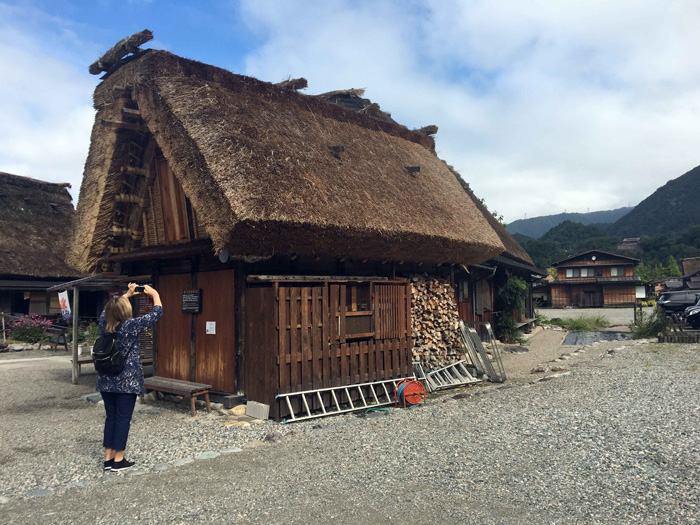
Shirakawa-go, a UNESCO World Heritage Site, is a unique thatched-roof village nestled in Japan's rugged Gifu Prefecture.
Situated at the headstream of the Sho River, Shirakawa-go's history began
in the early Middle Ages, under the aegis of Ujikatsu, a powerful local
lord. "In the old days, in order to earn hard cash," Jay reveals,
"families here were engaged in raising silkworms and in bottling
ingredients for gunpowder. Of course, today, they are very prosperous
due to tourism." We cross a footbridge over a rushing stream and
begin exploring the fairy-tale village. I am immediately struck by the
ingenuity of the houses. Built of natural materials, they are designed
to withstand strong winds, earthquakes, heavy snow and ice. "Someone
understood the principles of physics and how to disperse the force applied
to the roof during heavy winds and snow," my scientist husband observes
as he approaches a vintage thatched house.
The village charms at every turn. We cross a field with four scarecrows, already up for Halloween, on our way to Kanda House, one of the largest structures in the village and open to visitors. The house dates from the Edo period when it was built over ten-years by a carpenter from Ishikawa. Its multi-level interior is beautifully finished with gleaming floors. The "irori," a central fire pit, burns continuously, creating enough energy to warm the entire structure and allow for cooking. We notice that the house includes many modern improvements in keeping with the Gassho style, all held together by a system of ropes, pulleys and support boards. Small openings on different levels enable occupants to "watch out for fires that can escape the fire pit when gusty winds blow," our hostess explains. "Now let's head to a lookout point at the top of the ridge, the Ogimachi Joseki, where you can enjoy a panoramic view of the entire village," Jay announces as we depart. "There we will also have a traditional lunch featuring local specialties." Indeed, the view does not disappoint and our tasty lunch includes fresh trout and rustic buckwheat noodles.
Our bus loops through the mountainscape to Taira, a road station near Gokayama village. Here, a local factory produces "washi," an exquisite, hand-made paper derived from mixing fibers from mulberry branches and an extract from a hibiscus plant. "Time for another hands-on experience," I whisper to Kathy. "This paper has been made for over 1200 years and many historic documents written on washi were preserved by the old imperial court," Jay interjects. "Should washi paper ever get accidently wet, any ink writing on it will not be lost." A brief film summarizes the entire process, prepping us for our foray into papermaking, beginning with wet pulp and ending with a dry finished product. The staff is efficient and helpful and we each are gifted with our handiwork and other samples to take home. I am awed by how reverently the Japanese cling to age-old traditions. To this day, washi remains the paper of choice for cards and stationery, and especially for woodblock prints.
The alpine
terrain continues for another hour as our bus traverses the mountains
through a series of inky, winding tunnels, including one seven miles long.
Ahead lies Kanazawa, a prosperous city flanking the Japan Sea and one
of the best preserved municipalities in the country. During the Edo period,
Kanazawa was the domain of the powerful Maeda clan who ruled for three
centuries from a magnificent castle surrounded by a series of moats. The
city boasts some of the finest fish in the country, with numerous sushi
restaurants that attract an international following. "Before we arrive
at our hotel, we are going to stop at one of Kanazawa's old geisha areas,
the Higashi Chaya District," Jay announces. Under overcast skies,
we follow him through its picturesque streets, past lantern-lined alleyways,
artisanal shops, and several teahouses where geishas still entertain customers
with traditional songs and dances. The streets are packed with tourists,
including several young ladies from neighboring Asian countries who like
to dress up in colorful kimonos and strike a pose. They can easily pass
for locals and are delighted to be photographed. "There are a couple
of popular geisha houses here," Jay notes. "One has 24 active
girls. A typical show lasts 90 minutes and can cost $3000. All geishas
must be able to carry on intelligent conversations and also be amusing
and clever, in addition to performing for about three hours at a time."
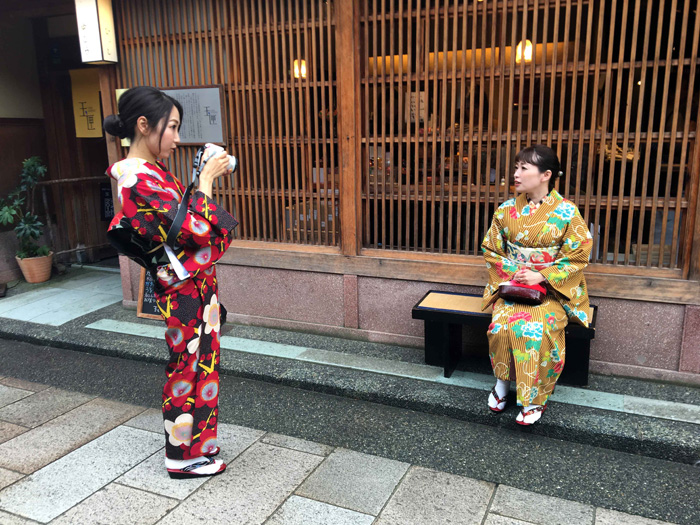
Kanazawa's historic Higashi Chaya District boasts several old geisha houses that attract locals and visitors. Girls from other Asian countries love to "play geisha" and pose in colorful kimonos.
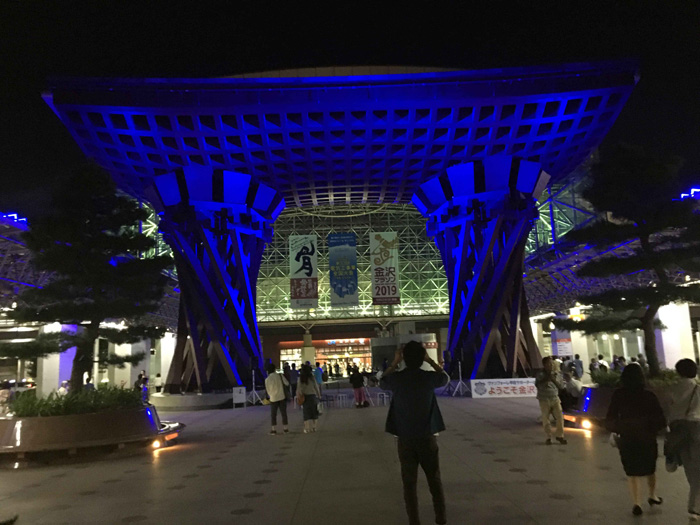
Kanazawa's famous train station, rebuilt in 2005, is famous for its illuminated gate, Tsuzumi mon, resembling the drum used in classical Noh Theater.
One could not ask to be based at a better hotel than the modern, 25-story Nikko, located just across the street from Kanazawa's dramatic, architect designed train station. Originally built in 1898, the station received a complete overhaul in 2005 by noted architects Sejima and Nishizawa. A massive cedar gate, the Tsuzumi-mon, is illuminated at night and resembles the drum used in classical Noh Theater. It has become the new trademark of the city. Inside, a ginormous glass and steel dome covers the central plaza, providing shelter from Kanazawa's frequent rains and heavy winter snows. "My recommendation is that we head to the Hyakubangai Shopping Center which connects to the station," Jay suggests. "There you will find many choices for dinner, from top sushi restaurants, noodle and tempura specialty places to Italian and fast food joints." He leads several of our group to Mori Mori, his very favorite sushi emporium, renowned for quality, freshness and presentation. "In my opinion Kanazawa's seafood surpasses Tokyo's," he asserts as he dives into his artfully arranged platter.
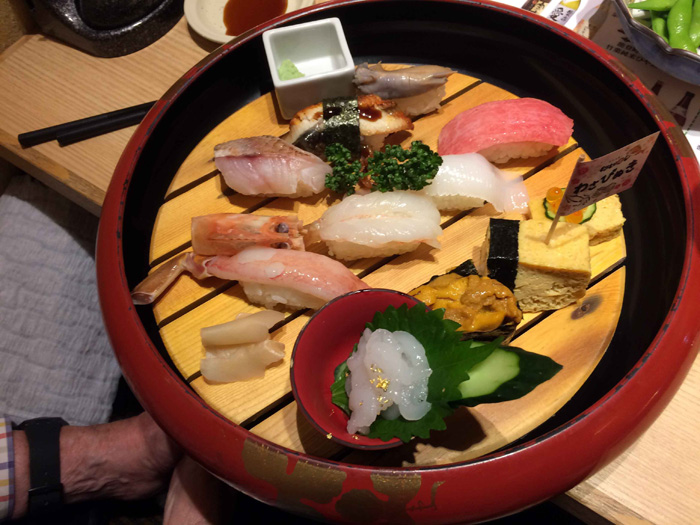
At Mori Mori, a sushi platter shows off the city's exceptional bounty from the Sea of Japan.
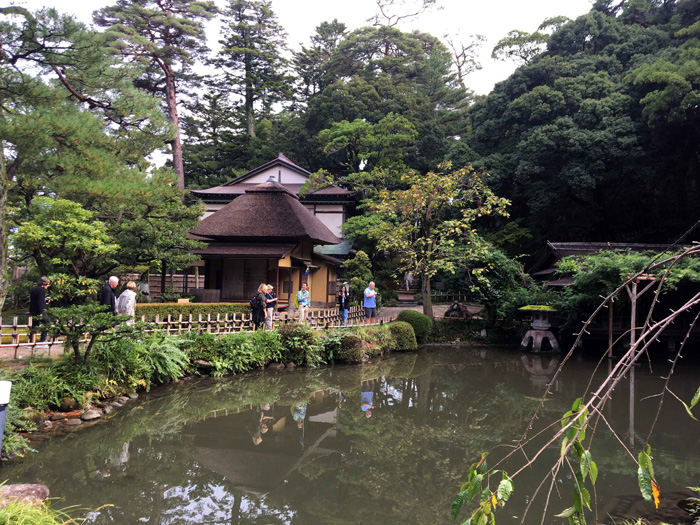
Kanazawa's 27-acre Kenrokuen Garden is renowned for its ancient pines and flowering trees, ponds, bridges and teahouses.
Early morning is the perfect time to visit the city's number one attraction,
its breathtaking Kenrokuen Garden. Commanding more than 27 acres, the
site embodies the "six sublimities" that are considered essential
to an authentic Japanese garden: spaciousness, tranquility, artifice,
antiquity, water features and striking views. Once the backyard of the
massive castle of the Maeda clan, it is planted with specimen trees, most
notably meticulously pruned pines, some hundreds of years old, and a profusion
of maple, cherry and plum trees. The garden also includes beautiful ponds
and waterfalls, bridges, teahouses, viewpoints, manicured flower beds
and delicate stonework. We pause to admire a two-meter lantern overlooking
a large pond. "This lantern is the symbol of the garden," Jay
remarks. He leads us to the eastern side of the garden toward a large
statue of a prince: "It is called the Meiji Monument and it is dedicated
to all the soldiers who died in the civil war that took place during 1868
and 1869, following the Meiji Restoration." Across the road from
the garden sits the reconstructed Maeda palace. Its massive gate is authentic,
but most of the original structure was destroyed by several fires. "Now
let's continue toward a unique community where the Maeda's samurai soldiers
used to live," Jay announces.
The centuries-old Nagamachi neighborhood is distinguished by winding cobbled lanes edged with earthen walls, water-filled canals, and intimate gardens. We stroll toward a restored home once occupied by the Nomura clan, a high-ranking samurai family with a penchant for refinement. Maeda purposefully encouraged all his top samurai to dabble in the arts. As a result, Kanazawa remained at peace and was not invaded for several centuries, its warriors perceived by rivals as posing no threat. We carefully cross over stepping stones to the entrance, past a gleaming suit of armor, through rooms with carved transoms and painted wall panels, to an intimate tea room overlooking a jewel of a garden with a waterfall and a pond stocked with koi. Several rooms on the first level showcase the family's collection of priceless artifacts. "Very well done," says Eric as we exit past a long line of visitors patiently waiting to enter. "It's good that we came early," he adds. I scan the crowd. Most of them are tourists from other parts of Japan eager to discover how the samurai elite once lived.
Kanazawa
is famous throughout Japan for its high-quality handicrafts. First among
them are its world renowned ceramics, known as Kutaniware, each piece
made by hand from blended clays, and expertly painted and glazed. At Kutani
Kosen Kiln, we are hosted by Koichiro Toshioka, the firm's president and
principal artist, a sixth-generation artisan with an exemplary command
of English. He takes us through their entire creative process, deftly
throwing pots himself on a wheel, enumerating the kiln's sources of quarried
clay and the firing and painting techniques used by the art staff. The
tour comes full circle at the gift shop where both antique and modern
pieces are for sale. "Our company was formed in 1870," Toshioka
brags as he wraps our purchase, a small vase glazed in brilliant yellow
and green. "Traditional Kutaniware dates back to the Edo period.
The name means nine valleys and surviving examples from the early days
are priceless," he explains. "With proper care your vase could
last forever."
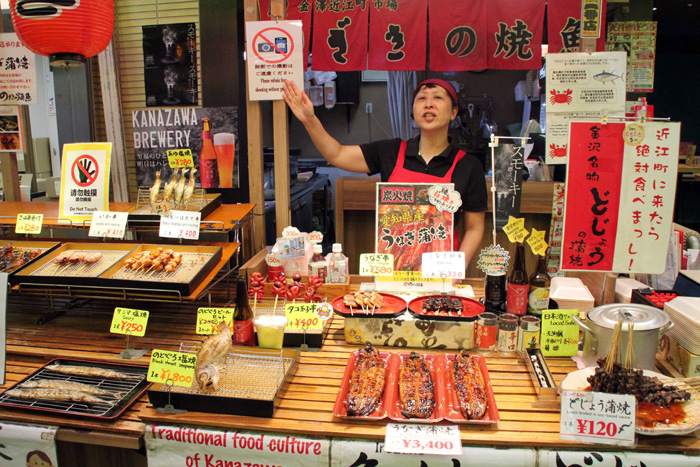
Omicho Market, also known as Kanazawa's Kitchen, is a bustling food hall with a huge selection of local fish.
Not far from the kiln is the city's colorful Omicho Market, a bustling
food hall especially popular for its huge selection of local fish plus
satellite eateries where hungry shoppers can sample it all. "This
market has been in operation since 1721," says Jay as he leads us
though several aisles. "The locals call it Kanazawa's kitchen,''
he shouts to be heard over the din. "Nearly all the seafood comes
directly from the Sea of Japan." We continue down an eye-popping
aisle, stopping to admire mounds of giant crabs and arrays of fish and
shrimp in many colors and sizes, freshly harvested sea urchins, trays
of grilled squid and oysters, and artfully arranged fruits and vegetables.
"Presentation is paramount in Japan," I comment to my husband,
"even in a food hall." But the fish bounty overwhelms, and the
four of us are totally ready for a change of pace. At Caffe Arco Mercato
at the edge of the market, we savor our Margherita pizzas and chilled
local beers.
The bus deposits
us at our final afternoon stop: the city's Yasue Gold Leaf Museum. Kanazawa
is Japan's largest producer of gold leaf, used for millennia to decorate
temples, palaces, statuary and even paintings and ceramics. "Gold
leaf is often added to cosmetics and to ice cream," Jay reveals.
A staff artist demonstrates the process of gold extraction, deftly applying
a thin sheet of gold leaf to an art object. "A few of the museum
staff actually live on the premises," Jay brags. "It's really
an amazing facility. There are workshop and conference spaces in addition
to a valuable collection." But for us, the stellar attraction is
a high-tech light show that reenacts the Maeda clan's history. The centerpiece
is Lord Maeda Toshiie's gilded suit of armor complete with his tall catfish
hat. Lights flash and dim, colors burst and dissolve, music blares and
fades as the clan's 300 years in Kanazawa gloriously enfold. Our visit
ends with a lesson in making a gold leaf plate. In a classroom, we are
each assigned a small lacquer plate and a stencil. After affixing a stencil
to the plate, we add some glue and lay a sheet of thin gold leaf on top,
then gently press to remove the stencil. The staff polishes our handiwork,
a perfect take-home souvenir.
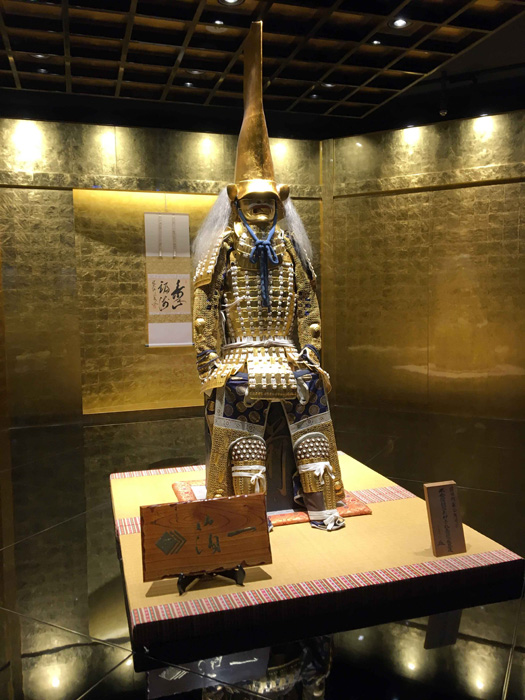
Lord Maeda Toshiie's gilded samurai armor is the centerpiece of the Gold Leaf Museum's high-tech light show.
It's our last night in Kanazawa. We stroll by moonlight to a private dining
room at Kagaya, a top-rated restaurant inside the train station. "Tonight
you are going to experience a 'fusion' kaiseki banquet," Jay announces
with pride, "and I think you are going to love it." An attentive
staff awaits to begin the rollout of dishes. Our salmon carpaccio (sashimi)
starter is followed by grilled beef on a hoba leaf. The next course is
jibu-ni, a tasty chicken and vegetable stew in a soy base, followed by
a crispy tempura of conger eel, sweet potato and green pepper, and a cleansing
miso soup. We end with a delicate pudding made with matcha green tea.
"Kanazawa is definitely a foodie's paradise," comments my husband
as we head back to the Nikko. "I would recommend this town to anyone
coming to Japan." "For sure," I nod. But I am already anticipating
our next adventure. In the morning we're taking a train to Kyoto, Japan's
reigning cultural capital. "Nothing like saving the best for last!"
I whisper in the evening breeze.
